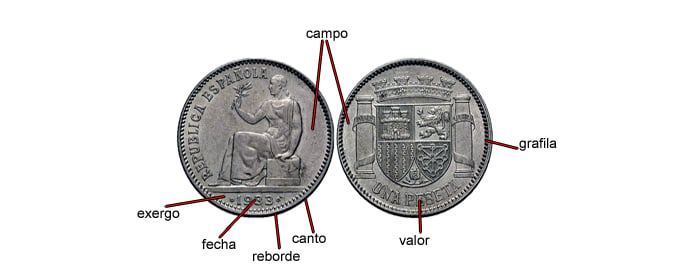Parts of a coin and their definitions
The following document details a glossary of the main parts of the coin. These parts are important when identifying and communicating with other numismatic collectors.
Front and back
The obverse of a coin, also called the face, etc., is the side of the coin that is considered to be the main side of the coin because it bears the most representative effigy or design. The reverse is usually inscribed with the value of the coin.
The reverse of a coin is the secondary side of the coin, opposite the obverse, which has a design of lesser importance than the face. It usually shows the face value. Also called the cross or reverse.
There is no general rule for distinguishing the obverse from the reverse.
Parts of a coin
This image displays the main parts of a coin.

Definitions parts of a coin
These are definitions of the main parts of a coin, depending on the coin, which may or may not contain them.
Alignment
If, when the coin is flipped from one side to the opposite side, the opposite side is turned 180 degrees, this is called coin alignment or non-coincident alignment, e.g. the peseta. If, on the other hand, the opposite side is not rotated, it is referred to as a medal alignment or coincident alignment, e.g. the Euro.
Border or Edge
The outer and lateral edge delimiting the two sides (obverse and reverse) of a coin.
Field
The epigraphic field is the surface where the inscription is engraved and the numismatic field is the part between the outline legends and the centre of the piece.
Poster
Box or band that frames an area of the epigraphic field and highlights the legends.
Mint
Mint, from the Hispano-Arabic sekka. Workshop or factory where coins are cradled. Also, the mark or inscription of the mint that mints coins and which generally appears on the obverse of the coin. The mint mark of the Madrid mint (FNMT) is currently represented by a crowned M. Previously the mintmark was a star which, depending on the number of points, indicated the mint.
Exergue
From the Greek ex-ergu, outside the work. The portion of the face of the coin below the main design, usually separated by the exergue line. The exergue is usually engraved with the date or mint, engraver's initials, etc.
Grafila
A circular line (usually dotted) or border that appears on both the obverse and the reverse, on the outermost part of the coin and bordering the edge.
Scales judge
In mints, the balance judge was the person in charge of weighing the gold, silver and other metals entering and leaving the mint, so that they were not allowed to leave without this requirement.
Law
The proportion of gold and silver in the coinage. It is measured in thousandths.
Module
Coin diameter. It is measured in millimetres.
Type
A coin of a certain value, design, modulus and metal, regardless of date or mintmark. Some people collect types and others collect by date and mint, even if the types are repeated.
The number of coins minted of a given type (value, design, modulus and metal) during a given minting date.